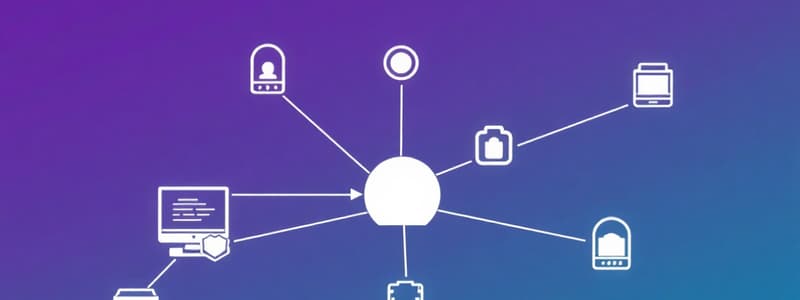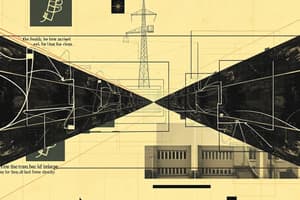Podcast
Questions and Answers
What is a significant reason businesses rely on data communications and networking?
What is a significant reason businesses rely on data communications and networking?
- To establish physical offices in multiple locations
- To access accurate information quickly for decision making (correct)
- To create visually appealing marketing materials
- To reduce operational costs by eliminating employees
Which of the following notations is used to represent different types of data in networks?
Which of the following notations is used to represent different types of data in networks?
- Binary and other types of codes (correct)
- Flowchart notation
- Graph notation
- Hierarchical notation
Which of the following best describes wide area networks (WANs)?
Which of the following best describes wide area networks (WANs)?
- Networks that connect multiple smaller networks over large geographical distances (correct)
- Networks that can only communicate using physical media like cables
- Networks that operate only within a small geographical area
- Networks that use wireless communication exclusively
What is the primary purpose of data flow through a network?
What is the primary purpose of data flow through a network?
Which era is NOT part of the brief history of the Internet as described?
Which era is NOT part of the brief history of the Internet as described?
What are the four different network topologies primarily used in networking?
What are the four different network topologies primarily used in networking?
What is the role of standards organizations in the context of the Internet?
What is the role of standards organizations in the context of the Internet?
Why are communities no longer isolated in accordance with advancements in data communications?
Why are communities no longer isolated in accordance with advancements in data communications?
What is the primary function of the switch in a switched network?
What is the primary function of the switch in a switched network?
In a circuit-switched network, what is the nature of the connection between end systems?
In a circuit-switched network, what is the nature of the connection between end systems?
When a host in the west coast office sends a message to another host in the same office, what happens?
When a host in the west coast office sends a message to another host in the same office, what happens?
What type of network is characterized as an internetwork?
What type of network is characterized as an internetwork?
Which statement describes a characteristic of packet-switched networks?
Which statement describes a characteristic of packet-switched networks?
In the context of WAN connections, what does 'point-to-point' refer to?
In the context of WAN connections, what does 'point-to-point' refer to?
What does the router do when routing messages between different offices?
What does the router do when routing messages between different offices?
Which of the following accurately describes the message-handling behavior of the switch in a LAN?
Which of the following accurately describes the message-handling behavior of the switch in a LAN?
What year did ARPANET get officially retired and replaced by NSFNET?
What year did ARPANET get officially retired and replaced by NSFNET?
Which three companies formed the nonprofit organization to build ANSNET?
Which three companies formed the nonprofit organization to build ANSNET?
What technological advancement contributed significantly to the popularity of the Internet in the 1990s?
What technological advancement contributed significantly to the popularity of the Internet in the 1990s?
What is the primary function of ANSNET?
What is the primary function of ANSNET?
Who is credited with the invention of the World Wide Web?
Who is credited with the invention of the World Wide Web?
What is essential for a specification to attain Internet standard status?
What is essential for a specification to attain Internet standard status?
What types of applications significantly increased user engagement with the Internet recently?
What types of applications significantly increased user engagement with the Internet recently?
What is the role of Internet standards in relation to Internet protocols?
What is the role of Internet standards in relation to Internet protocols?
What characterizes a switched WAN compared to a point-to-point WAN?
What characterizes a switched WAN compared to a point-to-point WAN?
How are internetworks formed in a typical organizational setup?
How are internetworks formed in a typical organizational setup?
What role do switches play in a switched WAN?
What role do switches play in a switched WAN?
Which statement about LANs and WANs is true based on the content?
Which statement about LANs and WANs is true based on the content?
What is a significant characteristic of WANs used in global communication today?
What is a significant characteristic of WANs used in global communication today?
Which of the following is not included in the definition of a switched WAN?
Which of the following is not included in the definition of a switched WAN?
In the context of network communications, what best describes an internetwork?
In the context of network communications, what best describes an internetwork?
What distinguishes a switched WAN from a simple WAN setup?
What distinguishes a switched WAN from a simple WAN setup?
What is the primary condition for a proposed standard to be elevated to a draft standard?
What is the primary condition for a proposed standard to be elevated to a draft standard?
Which maturity level indicates that an RFC has been superseded or has never passed necessary maturity levels?
Which maturity level indicates that an RFC has been superseded or has never passed necessary maturity levels?
What characterizes an experimental RFC?
What characterizes an experimental RFC?
At what maturity level is an RFC considered stable and of sufficient interest to the Internet community?
At what maturity level is an RFC considered stable and of sufficient interest to the Internet community?
How long is the lifetime of an Internet draft before it is subject to review or renewal?
How long is the lifetime of an Internet draft before it is subject to review or renewal?
Which of the following maturity levels is attained after successful implementation demonstrations?
Which of the following maturity levels is attained after successful implementation demonstrations?
What is the common timeframe for a draft standard to become an Internet standard, barring difficulties?
What is the common timeframe for a draft standard to become an Internet standard, barring difficulties?
What is a key characteristic of an informational RFC?
What is a key characteristic of an informational RFC?
What is the primary role of the Internet Society (ISOC)?
What is the primary role of the Internet Society (ISOC)?
Which component of the Internet Architecture Board (IAB) focuses on the technical management of Internet standards?
Which component of the Internet Architecture Board (IAB) focuses on the technical management of Internet standards?
Which body serves as the editorial manager of RFCs?
Which body serves as the editorial manager of RFCs?
What is a key responsibility of the Internet Engineering Task Force (IETF)?
What is a key responsibility of the Internet Engineering Task Force (IETF)?
How many areas are currently defined within the Internet Engineering Task Force (IETF)?
How many areas are currently defined within the Internet Engineering Task Force (IETF)?
Which organization acts as the technical advisor to the Internet Society (ISOC)?
Which organization acts as the technical advisor to the Internet Society (ISOC)?
What does the Internet Research Task Force (IRTF) primarily focus on?
What does the Internet Research Task Force (IRTF) primarily focus on?
Who manages the working groups within the Internet Engineering Task Force (IETF)?
Who manages the working groups within the Internet Engineering Task Force (IETF)?
Flashcards
Data Communications
Data Communications
The process of sharing information, exchanging knowledge, and conveying ideas between two or more entities.
Data Transmission
Data Transmission
Data communications involve the transmission of information using electronic signals through communication channels.
Network
Network
A collection of interconnected devices that enable data exchange.
Network Topology
Network Topology
Signup and view all the flashcards
Local Area Network (LAN)
Local Area Network (LAN)
Signup and view all the flashcards
Wide Area Network (WAN)
Wide Area Network (WAN)
Signup and view all the flashcards
Internet
Internet
Signup and view all the flashcards
Switching
Switching
Signup and view all the flashcards
Point-to-point WAN
Point-to-point WAN
Signup and view all the flashcards
Switched WAN
Switched WAN
Signup and view all the flashcards
Internetwork
Internetwork
Signup and view all the flashcards
Connecting Networks
Connecting Networks
Signup and view all the flashcards
LAN
LAN
Signup and view all the flashcards
WAN
WAN
Signup and view all the flashcards
Switching between Networks
Switching between Networks
Signup and view all the flashcards
Circuit
Circuit
Signup and view all the flashcards
Circuit-switched network
Circuit-switched network
Signup and view all the flashcards
Packet-switched network
Packet-switched network
Signup and view all the flashcards
Switch
Switch
Signup and view all the flashcards
Switched network
Switched network
Signup and view all the flashcards
Internet Draft
Internet Draft
Signup and view all the flashcards
Request for Comment (RFC)
Request for Comment (RFC)
Signup and view all the flashcards
Proposed Standard
Proposed Standard
Signup and view all the flashcards
Draft Standard
Draft Standard
Signup and view all the flashcards
Internet Standard
Internet Standard
Signup and view all the flashcards
Historic RFCs
Historic RFCs
Signup and view all the flashcards
Experimental RFCs
Experimental RFCs
Signup and view all the flashcards
Informational RFCs
Informational RFCs
Signup and view all the flashcards
What is ISOC?
What is ISOC?
Signup and view all the flashcards
What is the IAB?
What is the IAB?
Signup and view all the flashcards
What is the IETF?
What is the IETF?
Signup and view all the flashcards
What is the IRTF?
What is the IRTF?
Signup and view all the flashcards
What is the Internet?
What is the Internet?
Signup and view all the flashcards
How did the Internet evolve from ARPANET to NSFNET?
How did the Internet evolve from ARPANET to NSFNET?
Signup and view all the flashcards
What led to the creation of ANSNET?
What led to the creation of ANSNET?
Signup and view all the flashcards
What is the significance of the World Wide Web?
What is the significance of the World Wide Web?
Signup and view all the flashcards
How have multimedia applications impacted the internet?
How have multimedia applications impacted the internet?
Signup and view all the flashcards
What is peer-to-peer networking?
What is peer-to-peer networking?
Signup and view all the flashcards
What are Internet standards?
What are Internet standards?
Signup and view all the flashcards
What are administration entities in the internet?
What are administration entities in the internet?
Signup and view all the flashcards
Study Notes
Introduction to Data Communications and Networking
- Data communications and networking have revolutionized the way businesses and individuals operate.
- Decision-makers require quick and accurate access to information, a need met by computer networks and internet-works.
- Data communication and networking have wide-ranging applications in political and social spheres, connecting societies globally.
- Networks utilize various technologies for efficient data transfer.
- This chapter introduces the fundamental aspects of how networks function.
Chapter Structure
- Five sections are included in this chapter, offering a comprehensive overview of data communications and networks.
- Section 1: Introduces data communication, defining its components and the various types of data exchanged. It details data representation and flow.
- Section 2: Introduces network structures, outlining their criteria and four basic topologies.
- Section 3: Details different types of networks: LANs, WANs, and internets. Discusses the Internet.
- Section 4: Presents a brief history of the Internet.
- Section 5: Covers the standards governing and governing the administration of Internet protocols.
Data Communications Components
- Five key components are crucial for data communication:
- Message: the information to be transmitted
- Sender: the device originating the message
- Receiver: the device receiving the message
- Transmission medium: the physical path between sender and receiver
- Protocol: the set of rules governing their communication
Data Representation
- Text: Represented as bit patterns (sequences of 0s and 1s). Unicode is a prevalent coding system.
- Numbers: Represented directly as binary numbers.
- Images: Composed of pixels; bit patterns define pixel color. RGB (red, green, blue) is a common color representation.
- Audio: Continuous signals, not discrete.
- Video: Can be continuous (e.g., from a camera) or a combination of discrete images.
Data Flow in Networks
- Simplex: Unidirectional communication.
- Half-duplex: Communication in both directions, but only one direction at a time.
- Full-duplex: Allows simultaneous communication in both directions.
Networks: Key Criteria and Structures
- The interconnection of devices enabling communication.
- Key criteria: performance, reliability, and security.
- Network topologies: mesh, star, bus, and ring.
Network Types: LANs and WANs
- LAN (Local Area Network): Primarily privately owned, connecting hosts in a single location (office, building, campus).
- WAN (Wide Area Network): Larger geographical span, connecting devices (switches, routers, or modems), usually leased from service providers.
- Internetwork: A network of networks; combining LANs and WANs for broader communication.
Switching
- Circuit switching: Dedicated connection (circuit) is established before transmission.
- Packet switching: Data is broken into packets, routed independently, and reassembled at the destination.
Internet History
- Early communication networks (telegraph, telephone).
- Development of packet-switching technology.
- ARPANET, the precursor to the Internet, emerged in the 1960s.
- Development of TCP/IP protocols.
- The Internet's evolution from a research network to a global one.
Internet Standards and Administration
- The Internet Society (ISOC) supports the Internet standards process.
- The Internet Architecture Board (IAB) advises ISOC.
- The Internet Engineering Task Force (IETF) handles standardization tasks.
- The Internet Research Task Force (IRTF) addresses long-term Internet research topics.
- RFCs (Request for Comments) are documents detailing internet standards.
Studying That Suits You
Use AI to generate personalized quizzes and flashcards to suit your learning preferences.
Related Documents
Description
Test your knowledge on data communications and networking concepts! This quiz covers various topics including network types, topologies, data flow, and the history of the Internet. Perfect for students or professionals looking to assess their understanding of network infrastructures.




